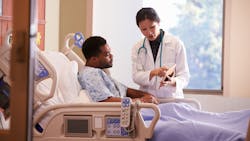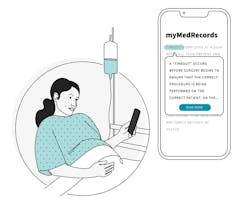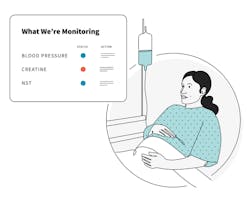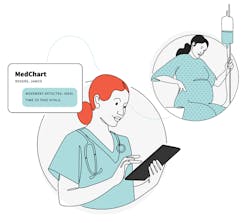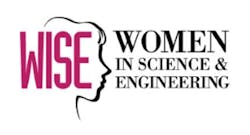How Emerging Technologies Can Transform the Hospital Experience
At a Glance:
- Downward pressure on healthcare systems affect the overall patient experience.
- Redesigning the hospital stay experience by leveraging emerging technologies can help alleviate some challenges.
- Technologies such as NLP, ML, AI, remote monitoring and automation are most likely to succeed when they are centered around the needs of the patient.
The Leapfrog Group, a national watchdog organization focused on healthcare safety, recently released its spring 2022 Safety Grade, which found that years of progress in the industry was reversed due to the pandemic. Critical areas of patient experience worsened with the responsiveness of hospital staff seeing the most significant decrease. Inadequacies in communication concerning medicine were frequent, and patients were also less likely to receive help when needed.
This decline in service quality was due to the immense pressure healthcare employees endured during the pandemic. Nevertheless, even before COVID-19, patients expressed less favorable sentiments during their hospital visits. And while the patient experience may be secondary to the actual treatment, studies show that facilities that foster better experiences tend to provide safer, higher quality care.
Redesigning the hospital stay experience goes beyond the limits of health care. For instance, patients may feel ignored by miscommunication, frustrated by constant night vital checks and confused by potential unexpected diagnoses.
Perhaps the solution to undoing the damages of the pandemic and mitigating growing dissatisfaction lies with advanced technologies that can improve the patient hospital experience, ensure quicker recovery time and ease the providers’ workload. These non-clinical procedures might include investing in wearable smart objects for patient monitoring and locating nearby hospital staff, applying machine learning to translate hospital jargon into common vernacular and utilizing TV monitors to observe patients.
READ MORE: Cut the Cables on Medical Devices to Improve Patient Mobility and Care
Non-Invasive Monitoring for Night Vital Checks
Emerging technology could resolve consistent and disrupted night vital checks. While crucial to ensuring the patient’s safety and speedy recovery, these checks can cause sleep deprivation, leading to many medical complications and negatively affecting the body’s immune and endocrine systems.
Similarly, lack of sleep can wreck someone’s blood pressure, increasing their risk of having a heart attack or stroke—sleep-deprived patients are also at a higher risk of becoming delirious or experiencing a fall. However, by implementing wearable devices, hospital staff can continue check-ins without waking patients and eliminate the harmful effects of sleep deprivation. These technology solutions could also assist night nurses by monitoring blood pressure, notifying staff when a patient is awake or helping them recognize sleep patterns to appropriately time vital checks.
Currently, there is an explosion in wearable devices that leverage sophisticated sensors and AI to measure things like diabetes, heart disease and disorders such as Parkinson’s and Alzheimer’s. Teslasuit, for example, offers a full-body haptic garment that can watch and collect biometric parameters in patients.
Putting Industry Jargon in Layman’s Terms
Another facet of the patient experience that the latest technology could enhance is how patients read medical notes. Although people have instant access to their medical records thanks to digital innovations, reading medical notes can be like looking at a new language. Patients often have to google abbreviations, acronyms and terminology to understand their own health conditions.
Likewise, words that seem to be layman’s terms may have different medical meanings. This communication barrier could cause a patient to feel everything from foolish and isolated to ignored or dismissed. Nonetheless, doctors need to maintain the medical accuracy of records to ensure they aren’t jeopardizing their patients’ health.
To reduce patient confusion and frustration without compromising on essential medical verbiage, healthcare organizations can leverage natural language processing (NLP) and machine learning (ML) to transcribe lengthy and complex records and reports into concise layman-oriented explanations.
A real-life example, but in another industry, is Southwest Airlines, which partnered with a global innovation design firm to build a prototype that could streamline the passenger pre-flight experience. The data used by airlines is enormous and steeped in industry terminology that can be almost incomprehensible to average fliers.
By using technology solutions like ML to synchronize channels, provide plain language definitions and “translate” airline lingo, passengers had a much more seamless and hassle-free effort finding their gates and arriving with time to spare. The medical sector could use these solutions to enrich communication between providers and patients, especially for information about medications.
Leapfrog Group Safety Grade’s spring findings indicate better communication concerning medication would lower rates of hospital-acquired conditions like sepsis and blood clots and lead to fewer surgical complications. Similarly, clear discharge information could reduce the likelihood of a patient being readmitted.
READ MORE: Delivering True Wireless Charging From a Distance
Articulating Expectations to Avoid Confusion
Unclear expectations concerning a hospital stay also represent a broader issue that could be ameliorated by technological advancements. Typically, healthcare professionals provide patients with a general sense of what is happening, but the finer details get left out of the timeline. Understandably, the staff is prioritizing more pressing tasks—however, unclear expectations can cause the patient to become anxious and impatient.
Numerous technologies, including patient smartphones, could be utilized to help improve expectation articulation while not sacrificing the precious time of busy employees. Patients could visualize their daily schedule through frequent updates sent to phones or room TVs. Likewise, with mapping tech and radio frequency identification (RFID), the patient will know where their providers are in the hospital and when a doctor or nurse might visit them.
Yet, constantly sending information to patients would be laborious and unrealistic for staff who are already overburdened and understaffed. To eliminate these manual processes, hospitals can use AI automation to reduce employee workload while enhancing the patient experience.
The Power of Automation
Various solutions can ease the medical providers’ endeavors, including robotics automation to handle administrative duties and chatbots utilizing NLP to schedule, cancel or reschedule appointments. These technologies have already profoundly impacted healthcare processes at all stages of the patient journey, from clinical assessment and diagnosis to follow-up care and billing.
As mentioned above, automation, AI and ML can also eliminate manual and respective tasks allowing medical professionals to spend more time focusing on providing the best care possible, truncating wait times and boosting the patient experience. The benefits of automation are multifold—this technology can lower costs by analyzing patient and operational data quickly and AI and ML can sift through massive amounts of data to discover insights.
In fact, as a result of automation, the healthcare industry has reduced administrative costs by $122 billion. Additionally, automation can decrease medical errors and improve diagnostic capabilities, ultimately creating healthier and more satisfied patients.
Using Data to Create Personalized Interactions
While technologies such as NLP, ML, AI, remote monitoring and automation will improve the patient experience, there are other considerations medical organizations must work through to provide patient-centric care. Patients have become more like consumers with very high expectations. Modern patients want to make an appointment at their preferred time and location and with their favored clinician. And 57% expect doctors to send them an email or text reminders to schedule and attend appointments.
The healthcare field can look to other consumer industries and emulate their data collection methods that allow them to tailor experiences to each customer or, in this case, patient. Medical organizations can collect data from various health records to personalize treatment options, communication and lifestyle-change programs.
Then, through advanced sensors, mobile devices and telehealth technologies, the patient experience can extend beyond traditional facilities and into the home, which has become a core means of accessing care since the pandemic.
Necessary Considerations with Technology Implementation
Implementing any advanced technology in healthcare can be a highly complex process. Healthcare administrators and executives will need to be educated on how solutions like automation interface with operations, as well as to consider all challenges and potential ramifications.
Likewise, as processes become digitized, medical providers should remember that although these technology innovations will empower better patient experiences, there is more to a great experience than fancy technology. The introduction of new systems might not be received with excitement as automation could put traditional administrative roles at risk, or AI could eliminate tasks clinicians held in the past, such as reading scans and making diagnoses.
Moreover, realizing these solutions will be highly involved and technical, hospitals and healthcare organizations should consider a capable technology partner, just as Southwest did to ensure regular operations go uninterrupted during the implementation process.
Rebecca Pinn is director, Innovation Strategy for EPAM Continuum. She holds a bachelor’s degree in mechanical engineering and a master’s degree in product development from Carnegie Mellon University.
Editor’s Note: Machine Design's Women in Science and Engineering (WISE) hub compiles our coverage of gender representation issues affecting the engineering field, in addition to contributions from equity seeking groups and subject matter experts within various subdisciplines.
About the Author
Rebecca Pinn
Director, Innovation Strategy, EPAM Continuum
Rebecca Pinn is director, Innovation Strategy for EPAM Continuum. She holds a bachelor’s degree in mechanical engineering and a master’s degree in product development from Carnegie Mellon University.
